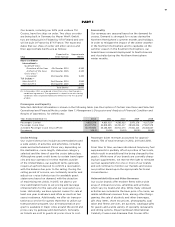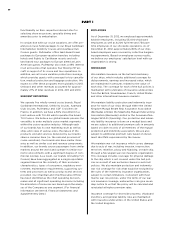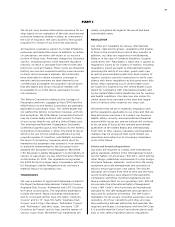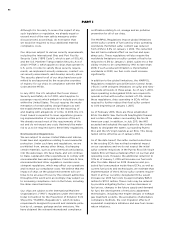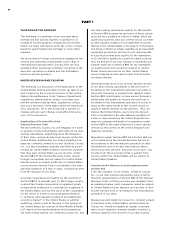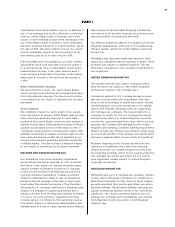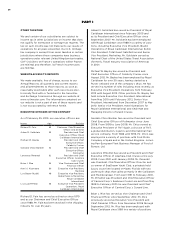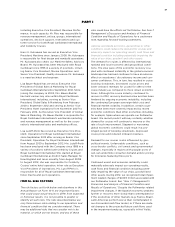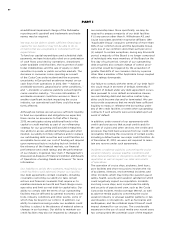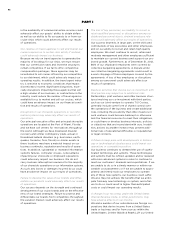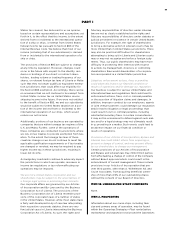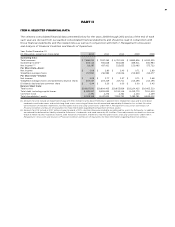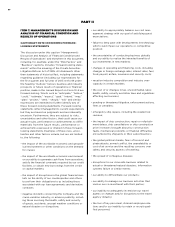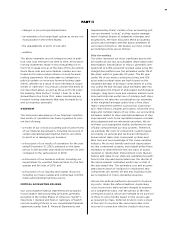Royal Caribbean Cruise Lines 2012 Annual Report Download - page 33
Download and view the complete annual report
Please find page 33 of the 2012 Royal Caribbean Cruise Lines annual report below. You can navigate through the pages in the report by either clicking on the pages listed below, or by using the keyword search tool below to find specific information within the annual report.
29
PART I
publicity that could be generated by those incidents.
If any such incident occurs during a time of high sea-
sonal demand, the effect could disproportionately
impact our results of operations for the year. In addi-
tion, any events which impact the travel industry
more generally may negatively impact our ability to
deliver guests to our cruises and/or interrupt our abil-
ity to obtain services and goods from key vendors in
our supply chain. Any of the foregoing could have an
adverse impact on our results of operations and on
industry performance.
The impact of disruptions in the global financial
markets may affect the ability of our counterparties
and others to perform their obligations to us.
The financial crisis of 2008, including failures of finan-
cial service companies and the related liquidity crisis,
disrupted the capital and credit markets and addi-
tional economic concerns from some of the countries
in the European Union continue to strain the financial
markets both in the US and internationally. A recur-
rence of these disruptions could cause our counter-
parties and others to breach their obligations to us
under our contracts with them. This could include fail-
ures of banks or other financial service companies to
fund required borrowings under our loan agreements
or to pay us amounts that may become due under our
derivative contracts for hedging of fuel prices, inter-
est rates and foreign currencies or other agreements.
If any of the foregoing occurs it may have a negative
impact on our cash flows, including our ability to
meet our obligations, our results of operations and
our financial condition.
An increase in capacity worldwide or excess capacity
in a particular market could adversely impact our
cruise sales and/or pricing.
Although our ships can be redeployed, cruise sales
and/or pricing may be impacted both by the intro-
duction of new ships into the marketplace and by
deployment decisions of ourselves and our compe-
titors. A total of 19 new ships with approximately
65,000 berths are on order for delivery through 2017
in the cruise industry. The further growth in capacity
from these new ships and future orders, without an
increase in the cruise industry’s share of the vacation
market, could depress cruise prices and impede our
ability to achieve yield improvement. In addition, to
the extent that we or our competitors deploy ships to
a particular itinerary and the resulting capacity in that
region exceeds the demand, we may lower pricing
and profitability may be lower than anticipated. Any
of the foregoing could have an adverse impact on our
results of operations, cash flows and financial condi-
tion including potentially impairing the value of our
ships, goodwill and other assets.
If we are unable to appropriately balance our cost
management strategy with our goal of satisfying
guest expectations, it may adversely impact our
business success.
Our goals call for us to provide high quality products
and deliver high quality services. There can be no
assurances that we can successfully balance these
goals with our cost containment efforts.
We may lose business to competitors throughout the
vacation market.
We operate in the vacation market and cruising is one
of many alternatives for people choosing a vacation.
We therefore risk losing business not only to other
cruise lines, but also to other vacation operators,
which provide other leisure options including hotels,
resorts and package holidays and tours.
We face significant competition from other cruise
lines on the basis of cruise pricing, travel agent pref-
erence and also in terms of the nature of ships and
services we offer to guests. Our principal competitors
within the cruise vacation industry include Carnival
Corporation & plc, which owns, among others, Aida
Cruises, Carnival Cruise Lines, Costa Cruises, Cunard
Line, Holland America Line, Iberocruceros, P&O
Cruises and Princess Cruises; Disney Cruise Line; MSC
Cruises; Norwegian Cruise Line and Oceania Cruises.
In the event that we do not compete effectively with
other vacation alternatives and cruise companies, our
results of operations and financial position could be
adversely affected.
Fears of terrorist and pirate attacks, war, and other
hostilities and the spread of contagious diseases could
have a negative impact on our results of operations.
Events such as terrorist and pirate attacks, war, and
other hostilities and the resulting political instability,
travel restrictions, the spread of contagious diseases
and concerns over safety, health and security aspects
of traveling or the fear of any of the foregoing have
had, and could have in the future, a significant adverse
impact on demand and pricing in the travel and vaca-
tion industry. As we continue to globalize our opera-
tions, we become susceptible to a wider range of
adverse events.
Fluctuations in foreign currency exchange rates could
affect our financial results.
We earn revenues, pay expenses, recognize assets
and incur liabilities in currencies other than the U.S.
dollar, including, among others, the British pound
sterling, the Canadian dollar, the euro, the Australian
dollar and the Brazilian real. In 2012, we derived
approximately 49% of revenues from operations out-
side the United States. Because our consolidated


